OLED, technology and applications
OLEDs are a new class of light sources that open up completely new scenarios in lighting. Like LED technology, OLEDs are solid-state devices, but the nature of their surfaces opens up a world of luminescent skins – luminous surfaces that can transform the perception of light itself. Like their LED "cousins", OLEDs are light-emitting diodes. However, they exploit the qualities of "organic" electronics: thin plastic films having the thickness of a sheet of paper that can emit light in response to an electric current. OLED technology offers significant advantages (low voltage, high contrast, bright colours) with some limitations. First of all, the cost is still very high. LEDs and OLEDs both use some semiconductor materials, suitably "doped" to produce photons when a difference in electric potential is applied. Today, these materials are the new technological frontier in the development of a multitude of innovative products, such as OLEDs of course, but also for organic solar cells and other applications including memories, organic sensors, flexible batteries, electronic paper and many more. We are therefore transitioning from laboratory testing and prototype development to industrial production. Market forecasts published by OLED manufacturers indicate that the first generation of serial products will be on the market by 2012, while from 2012 to 2018, we will see the advent of true standardised industrial production.
What are OLEDs?
OLEDs – organic light-emitting diodes – are made up of stacked layers of organic material (100 nanometres each) placed between an anode and a cathode. The substrate, at present, is a thin sheet of glass with a transparent conductive layer – the anode – which is overlapped by the organic layers of holes and electrons. This, in turn, is followed by an inorganic cathode. Experiments, however, are showing that the use of a thin, flexible film is opening entirely new horizons. In the architecture of this new generation of products, the heirs to "organic" electronics, there is a striking similarity between products that are "traditionally" of different typologies but which, with new production processes similar to printing, are developing new formal and functional affinities. This "symmetry" regards solar cells, for example. Their architecture is similar to that of the OLEDs, with the difference that the organic material that emits electrons and holes is replaced by a material which absorbs the photons of sunlight. In a certain sense, the two systems are mirror images: one material stimulated by an electric current emits light; while the other, hit by light, emits electrical current. It is therefore easy to imagine that in the future such a familiar element as a window might be able to store energy during the day and then return it in the form of light. In other words, it could function as a solar cell or luminous surface as necessary. When switched off, the OLED can be transparent so that a whole generation of new products can be imagined. Potential applications range from small decorative lamps and signs to lighting integrated with architecture such as luminous ceilings or flexible luminous furnishings that can be folded or rolled up, thus creating numerous uses for illuminating buildings, aircraft or car interiors (ceilings of passenger compartments, for example) with considerable advantages in terms of lightness and reduced energy consumption. The emitted light is also particularly suited to heat-sensitive applications such as refrigeration or display stands for food, since the emitted light has rather low power per unit area, does not produce glare or generate large amounts of heat.
Organic Electronics versus Silicon
In OLED technology, light emission occurs when voltage is applied to organic materials. In this case, organic is intended as a plastic material based on the carbon chain. Organic semiconductors are composed both of "small molecules" with low molecular weight as well as of long polymer chains. Small molecules are deposited by thermal evaporation under vacuum, while layers of long-chain polymers use the ink-jet printing system. This production process is cheaper than traditional silicon manufacturing techniques, which result in high melting temperatures and require numerous steps (from ingot to wafer). Organic electronics moves towards light manufacturing and cost reduction. Compared with silicon technologies requiring great investments and heavy infrastructure, organic electronics opens up scenarios calling for light equipment and technologies similar to those used in newspaper printing (such as roll-to-roll fabrication).
Sustainability
Since 19 per cent of global energy consumption is used for the production of light, the possibility for significant savings frames the issue of OLEDs in terms of environmental sustainability. Efficiency of the sources – i.e. how they transform electrical energy into light energy – is an increasingly important parameter at a time when new energy regulations throughout the world are legislating the decommissioning of inefficient lighting products and, therefore, the renewal of light sources. OLEDs, like LEDs, have high efficacy rates of about 100 to 120 lumens per Watt (Lm/W) for the LEDs, and 65 Lm/W for the OLEDs (whereas an incandescent bulb consumes 15 to 20 Lm/W). Moreover, OLEDs do not contain hazardous substances like mercury, thus minimising the problem of recycling. Alberto Meda
Sticky Postings
All 242 fabric | rblg updated tags | #fabric|ch #wandering #reading
By fabric | ch
-----
As we continue to lack a decent search engine on this blog and as we don't use a "tag cloud" ... This post could help navigate through the updated content on | rblg (as of 09.2023), via all its tags!
FIND BELOW ALL THE TAGS THAT CAN BE USED TO NAVIGATE IN THE CONTENTS OF | RBLG BLOG:
(to be seen just below if you're navigating on the blog's html pages or here for rss readers)
--
Note that we had to hit the "pause" button on our reblogging activities a while ago (mainly because we ran out of time, but also because we received complaints from a major image stock company about some images that were displayed on | rblg, an activity that we felt was still "fair use" - we've never made any money or advertised on this site).
Nevertheless, we continue to publish from time to time information on the activities of fabric | ch, or content directly related to its work (documentation).
Monday, March 13. 2023
Atomized (re-)Staging short video documentation | #fabricch #digital #hybrid #exhibition
Note: a brief video documentation about one of fabric | ch's latest project – Atomized (Re)Staging – that was exhibited at ZKM during Matter. Non-Matter. Anti-Matter.
The exhibition was curated by Lívía Nolasco-Roszás and Felix Koberstein and took place ibn the context of the European research project Beyond Matter.
![]()
-----
Wednesday, October 19. 2016
Le médium spirite ou la magie d’un corps hypermédiatique à l’ère de la modernité | #spirit #media #technology
Note: following the previous post that mentioned the idea of spiritism in relation to personal data, or forgotten personal data, but also in relation to "beliefs" linked to contemporary technologies, here comes an interesting symposium (Machines, magie, médias) and post on France Culture. The following post and linked talk from researcher Mireille Berton (nearby University of Lausanne, Dpt of Film History and Aesthetics) are in French.
Via France Culture
-----
Cerisy : Machines, magie, médias (du 20 au 28 août 2016)
Les magiciens — de Robert-Houdin et Georges Méliès à Harry Houdini et Howard Thurston suivis par Abdul Alafrez, David Copperfield, Jim Steinmeyer, Marco Tempest et bien d’autres — ont questionné les processus de production de l’illusion au rythme des innovations en matière d’optique, d’acoustique, d’électricité et plus récemment d’informatique et de numérique.
Or, toute technologie qui se joue de nos sens, tant qu’elle ne dévoile pas tous ses secrets, tant que les techniques qu'elle recèle ne sont pas maîtrisées, tant qu’elle n’est pas récupérée et formalisée par un média, reste à un stade que l’on peut définir comme un moment magique. Machines et Magie partagent, en effet, le secret, la métamorphose, le double, la participation, la médiation. Ce parti pris se fonde sur l’hypothèse avancée par Arthur C. Clarke : "Toute technologie suffisamment avancée est indiscernable de la magie" (1984, p. 36).
L’émergence même des médias peut être analysée en termes d’incarnation de la pensée magique, "patron-modèle" (Edgar Morin, 1956) de la forme première de l’entendement individuel (Marcel Mauss, 1950). De facto, depuis les fantasmagories du XVIIIe siècle jusqu’aux arts numériques les plus actuels, en passant par le théâtre, la lanterne magique, la photographie, le Théâtrophone, le phonographe, la radio, la télévision et le cinéma, l’histoire des machineries spectaculaires croise celle de la magie et les expérimentations de ses praticiens, à l’affût de toute nouveauté permettant de réactualiser les effets magiques par la mécanisation des performances. C’est par l’étude des techniques d’illusion propres à chaque média, dont les principes récurrents ont été mis au jour par les études intermédiales et l’archéologie des médias, que la rencontre avec l’art magique s’est imposée.
Ce colloque propose d’en analyser leur cycle technologique : le moment magique (croyance et émerveillement), le mode magique (rhétorique), la sécularisation (banalisation de la dimension magique). Ce cycle est analysé dans sa transversalité afin d’en souligner les dimensions intermédiales. Les communications sont ainsi regroupées en sept sections : L’art magique ; Magie et esthétiques de l’étonnement ; Magie, télévision et vidéo ; Les merveilles de la science ; Magie de l’image, l’image et la magie ; Magie du son, son et magie ; Du tableau vivant au mimétisme numérique. La première met en dialogue historiens et praticiens de la magie et présente un état des archives sur le sujet. Les six sections suivantes font état des corrélations: magie/médias et médias/magie.
Docteure ès Lettres, Mireille Berton est maître d’enseignement et de recherche à la Section d’Histoire et esthétique du cinéma de l'Université de Lausanne (UNIL).
Ses travaux portent principalement sur les rapports entre cinéma et sciences du psychisme (psychologie, psychanalyse, psychiatrie, parapsychologie), avec un intérêt particulier pour une approche croisant histoire culturelle, épistémologie des médias et Gender Studies.
Outre de nombreuses études, elle a publié un livre tiré de sa thèse de doctorat intitulé Le Corps nerveux des spectateurs. Cinéma et sciences du psychisme autour de 1900 (L’Âge d’Homme, 2015), et elle a co-dirigé avec Anne-Katrin Weber un ouvrage collectif consacré à l’histoire des dispositifs télévisuels saisie au travers de discours, pratiques, objets et représentations (La Télévision du Téléphonoscope à YouTube. Pour une archéologie de l'audiovision, Antipodes, 2009). Elle travaille actuellement sur un manuscrit consacré aux représentations du médium spirite dans les films et séries télévisées contemporains (à paraître chez Georg en 2017).
Résumé de la communication:
L'intervention propose de revenir sur une question souvent traitée dans l’histoire des sciences et de l’occultisme, à savoir le rôle joué par les instruments de mesure et de capture dans l’appréhension des faits paranormaux. Une analyse de sources spirites parues durant les premières décennies du XXe siècle permet de mettre au jour les tensions provoquées par les dispositifs optiques et électriques qui viennent défier le corps tout-puissant du médium spirite sur son propre territoire. La rencontre entre occultisme et modernité donne alors naissance à la figure (discursive et fantasmatique) du médium "hypermédiatique", celui-ci surpassant toutes les possibilités offertes par les découvertes scientifiques.
Related Links:
Friday, November 25. 2011
Electronic contact lens displays pixels on the eyes
Via The New Scientist Via Computed·Blg
-----

(Image: Institute of Physics)
The future of augmented-reality technology is here - as long as you're a rabbit. Bioengineers have placed the first contact lenses containing electronic displays into the eyes of rabbits as a first step on the way to proving they are safe for humans. The bunnies suffered no ill effects, the researchers say.
The first version may only have one pixel, but higher resolution lens displays - like those seen in Terminator - could one day be used as satnav enhancers showing you directional arrows for example, or flash up texts and emails - perhaps even video. In the shorter term, the breakthrough also means people suffering from conditions like diabetes and glaucoma may find they have a novel way to monitor their conditions.
In February, New Scientist revealed the litany of research projects underway in the field of contact lens enhancement. While one company has fielded a contact lens technology using a surface-mounted strain gauge to assess glaucoma risk, none have built in a display, or the lenses needed for focused projection onto the retina - and then tested it in vivo. They have now.
"We have demonstrated the operation of a contact lens display powered by a remote radiofrequency transmitter in free space and on a live rabbit," says a US and Finnish team led by Babak Praviz of the University of Washington in Seattle.
"This verifies that antennas, radio chips, control circuitry, and micrometre-scale light sources can be integrated into a contact lens and operated on live eyes."
The test lens was powered remotely using a 5-millimetre-long antenna printed on the lens to receive gigahertz-range radio-frequency energy from a transmitter placed ten centimetres from the rabbit's eye. To focus the light on the rabbit's retina, the contact lens itself was fabricated as a Fresnel lens - in which a series of concentric annular sections is used to generate the ultrashort focal length needed.
They found their lens LED glowed brightly up to a metre away from the radio source in free space, but needed to be 2 centimetres away when the lens was placed in a rabbit's eye and the wireless reception was affected by body fluids. All the 40-minute-long tests on live rabbits were performed under general anaesthetic and showed that the display worked well - and fluroescence tests showed no damage or abrasions to the rabbit's eyes after the lenses were removed.
While making a higher resolution display is next on their agenda, there are uses for this small one, say the researchers: "A display with a single controllable pixel could be used in gaming, training, or giving warnings to the hearing impaired."
"This is clearly way off in the future. But we're aware of the research that is ongoing in this field and we're watching the technology's potential for biosensing and drug delivery applications in particular," says a spokesperson for the British Contact Lens Association in London.
Monday, December 20. 2010
Oled: a technology of the future
Via DOMUS
-----
A design report from Munich by Alberto Meda
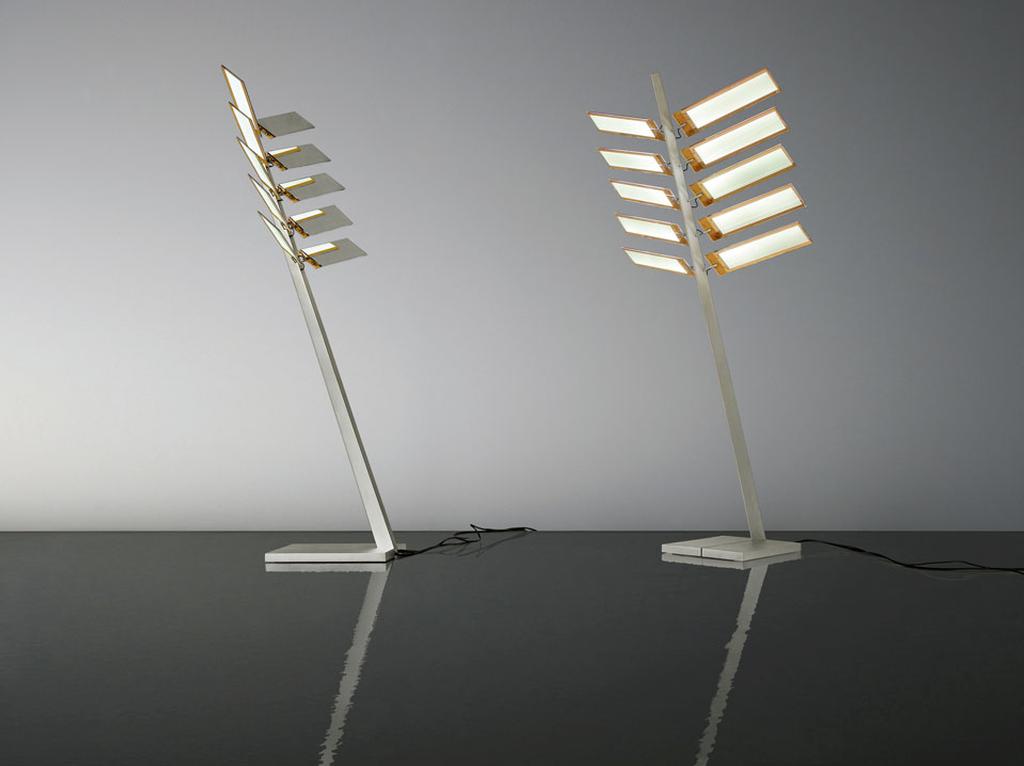
A luminous surface that represents a turning point in the history of artificial light
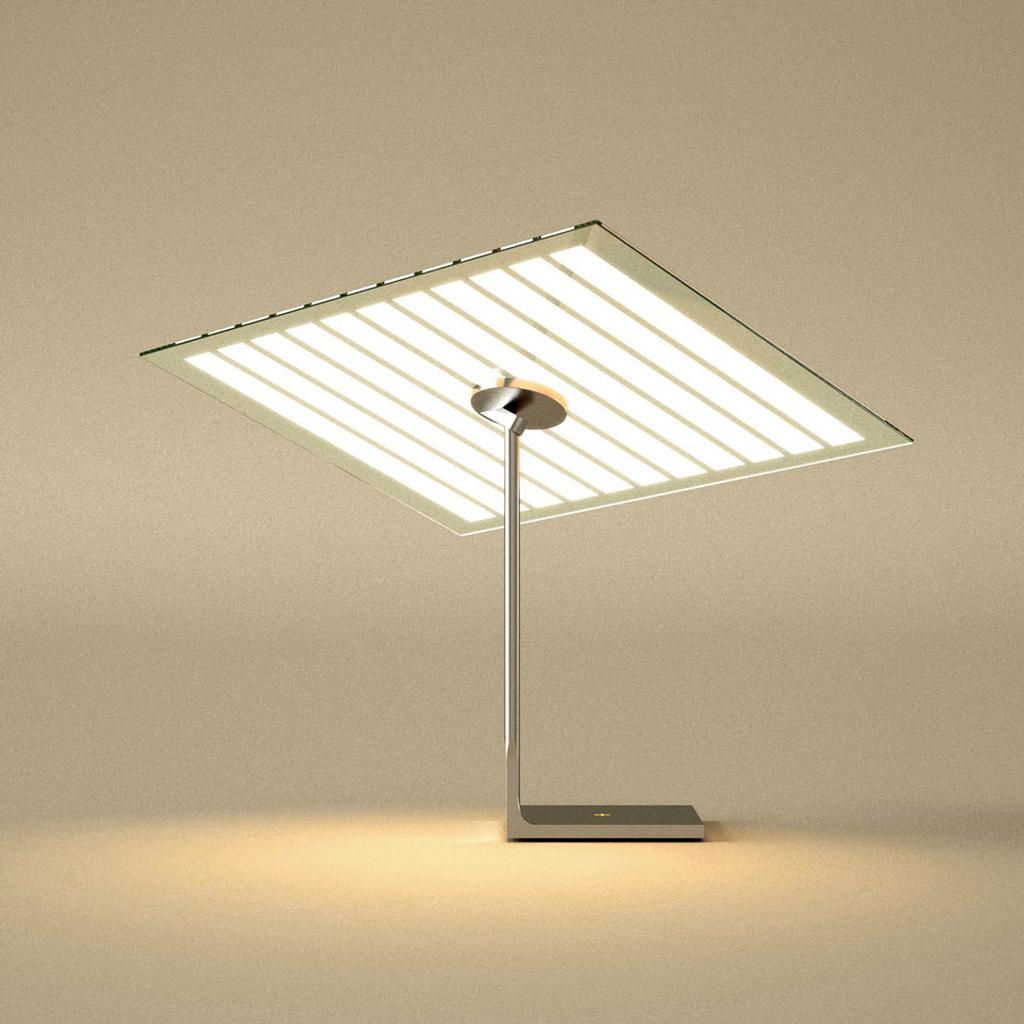
OLED: Ingo Maurer and practical experimentation
When we started working with OLEDs about four years ago, the technology was at a totally experimental stage. In just a few years, there has been great progress in terms of the light modules' lifespan and efficiency, but there are still only a handful of companies that can cope with anything near mass production. Four years on, you can still say that OLEDs are a technology of the future. When we presented Early Future in 2008, we were the first to design and make a lamp using OLEDs. Early Future was a table lamp fitted with ten OLED modules developed in collaboration with Osram and produced in a limited edition of 25 pieces. It was a very advanced design. This year we have presented new lighting objects using OLEDs, and these represent a major advancement on that first project. But I do think that what is on the market today should only be seen as experiments. We have not yet reached a stage where you can imagine a mass product. We are starting to catch sight of it, but it will take a few more years. Recently Ingo and I attended a seminar on OLEDs. There is such technical complexity behind them that it's hard to predict crucial advancements in the next two years. The next step is for industry to develop an efficient and long-lasting light module at a reasonable price that can incorporate mass-produced OLEDs. When we first approached OLEDs, we were immediately fascinated because the technology offers options we never had before. It has always been extremely complicated to create a lightweight luminous surface. This light source is of a very high quality; the light module is very slender, very clear and very efficient. It doesn't need screening, diffusers, reflectors or even bulb sockets: the light source can be used as it is, bare and with little else. In a certain sense, all the OLED light objects we have designed react to the quality of the OLEDs. You can introduce a movement, direct the modules and play with the light – there is great flexibility in the design. But we are at the experimental stage. The problem is still the power, the lifespan and, without doubt, the price, which remains too high. We can make beautiful objects with OLEDs but they are still very costly, not just in terms of single modules, but also the technique, which has to be developed with the manufacturers. When we worked with Osram and with Novaled, we jointly addressed the connection methods. Moreover, there is almost nothing in the way of bulb sockets or module holders. The same applied to LEDs. When we started out with the first modules in 1997, they were very expensive and there were no standards. In terms of light quality, OLEDs produce a very even light. It is very likely that, in the future, OLEDs will be used for general lighting as occurs today with fluorescent tubes, but with the bonus that OLEDs are much more slender, extremely lightweight and greatly reduce energy consumption. In addition, LEDs are the perfect completion for OLEDs. LEDs are small points that emit light and need a reflector or optics to diffuse the light, whereas OLEDs provide a luminous surface. They emit very soft, diffuse light, exactly the opposite of LED light points. Today, the ball is in the court of industry. It all depends on what it can come up with in terms of the size of modules put on the market. Until now, we have worked with quite small modules. In the future, we can imagine having larger modules and surfaces, and integrating them into walls or ceilings to produce a diffused general light. It would also be very interesting to use flexible modules to create 3D lights. The experiments we conducted with Novaled on Flying Future also indicate a new direction of research that applies transparent modules and suggests, for example, a new generation of windows or transparent luminous surfaces.
Taken from a conversation with Bernhard Dessecker, designer at Ingo Maurer GmbH. ![]()
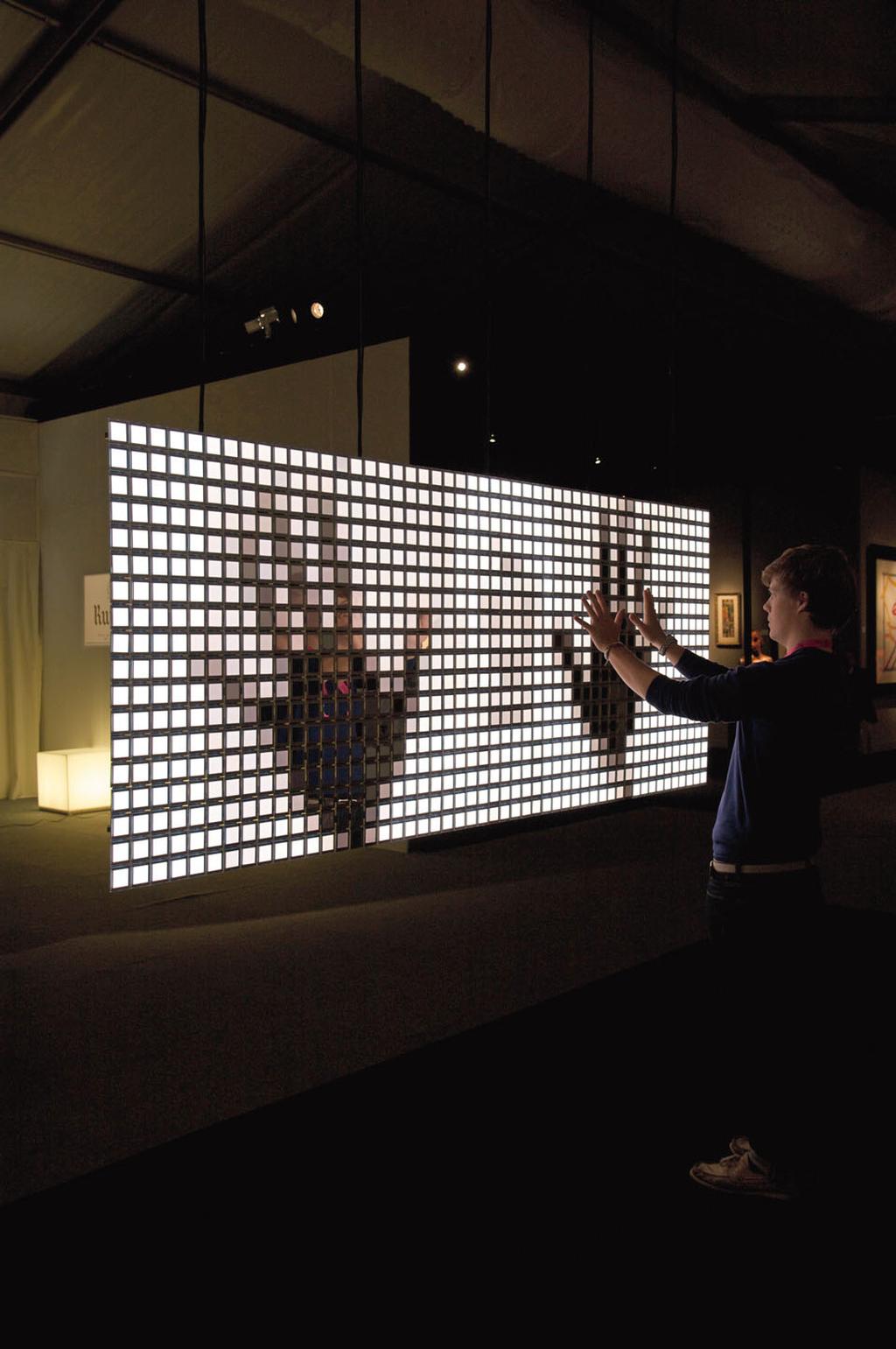

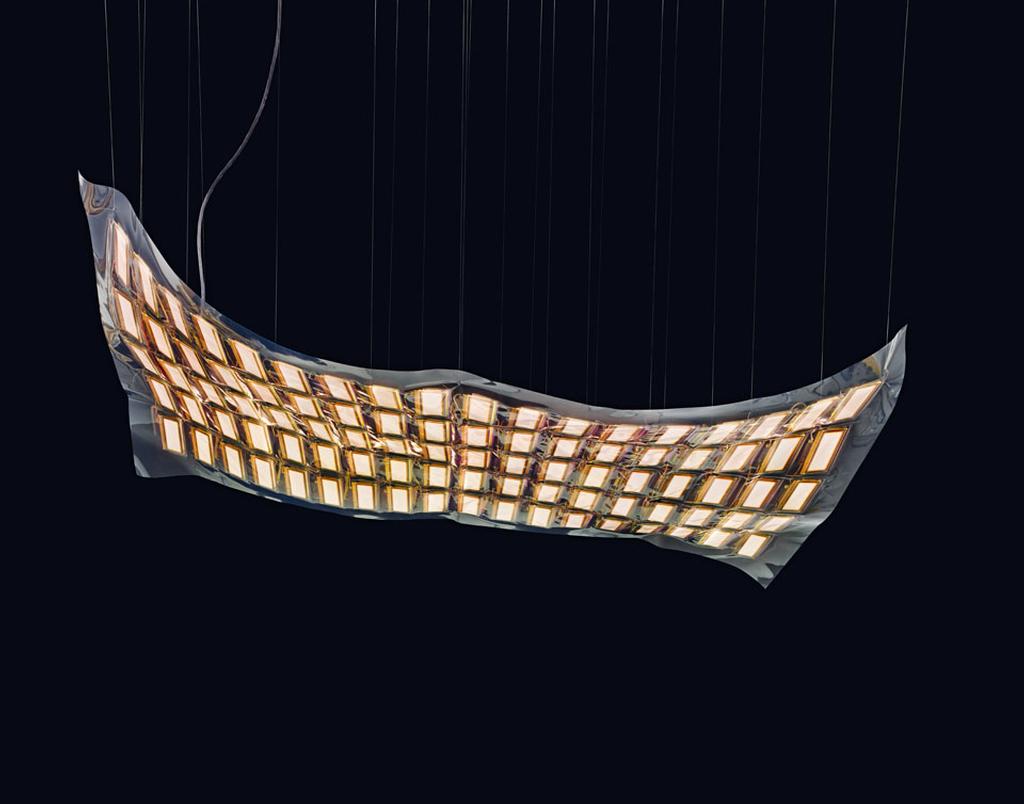
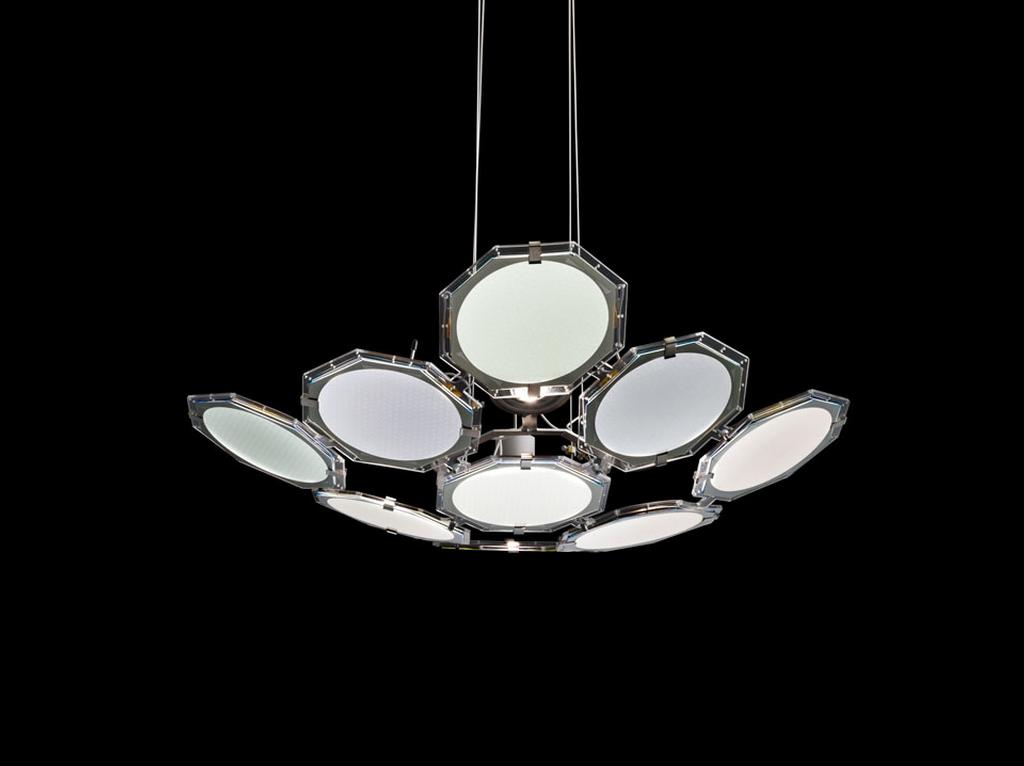
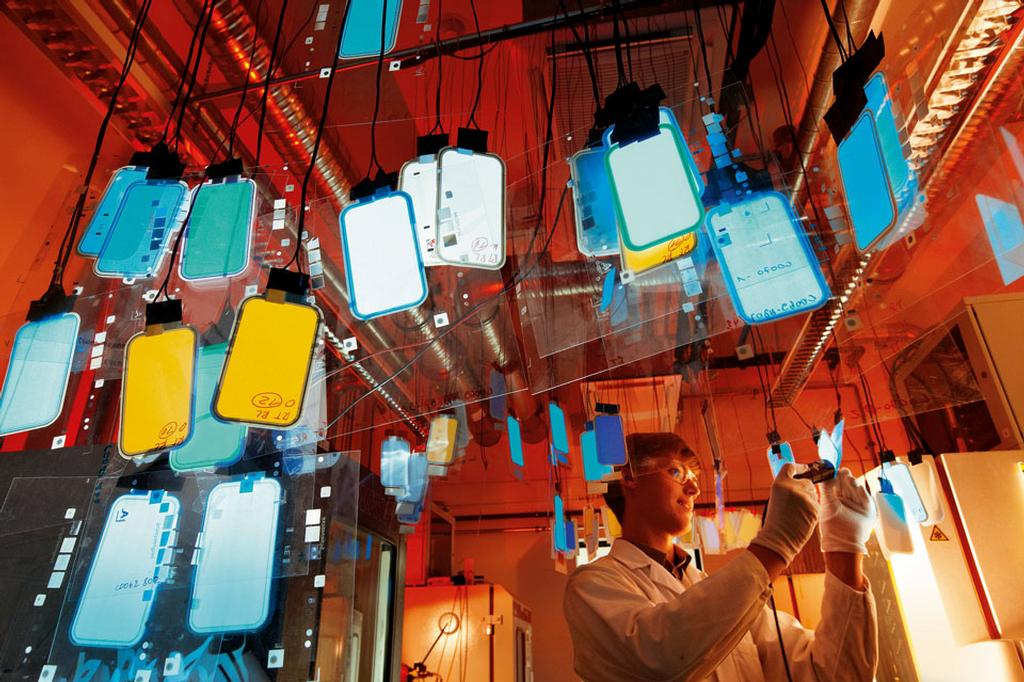
Personal comment:
Can also be used for windows of course, as the oled can be transparent when not lit and semi-transparent when lit.
Thursday, December 02. 2010
Thanks, Gutenberg ...
Links, via City of Sound via The Guardian
-----
Thanks, Gutenberg - but we're too pressed for time to read [The Observer]
"The study confirms what many are beginning to suspect: that the web is having a profound impact on how we conceptualise, seek, evaluate and use information. What Marshall McLuhan called 'the Gutenberg galaxy' - that universe of linear exposition, quiet contemplation, disciplined reading and study - is imploding, and we don't know if what will replace it will be better or worse."
Tuesday, August 10. 2010
Intimacy by Studio Roosegaarde and V2_
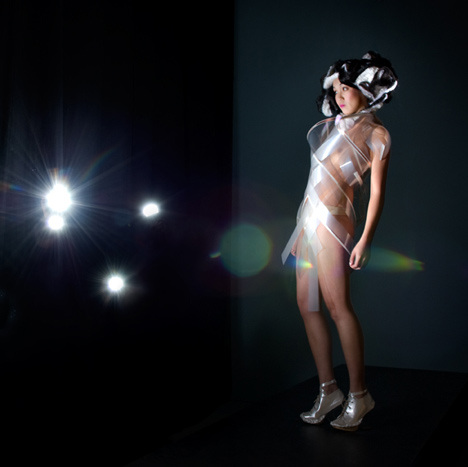
These dresses by Dutch designers Studio Roosegaarde and V2 become transparent when approached.
(more...)
Related Links:
Personal comment:
Quite active in the field of architecture & interaction design, environment design, Studio Roosegaarde makes a try in the field of fashion design with this interactive garment.
Thursday, July 15. 2010
Flexible displays in webOS's (distant) future?
Via PreCentral
-----
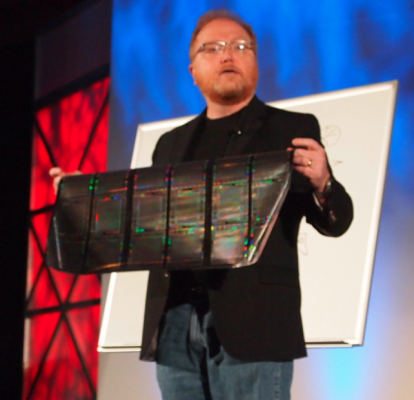
As we mentioned in our liveblog and wrap-up of Phil McKinney's keynote at MobileBeat 2010, HP's CTO was very clear that he wasn't announcing any new hardware - he likes webOS's chances on a "Slate device" but not on the Slate device.
McKinney also broke out both a Palm Pre and a Palm Pixi, but the most interesting thing he pulled out during his speech was a rolled-up flexible display. What you're looking at is something from deep inside HP's R&D, it's similar to E-Ink, printed on Mylar, and essentially can be made into any size you can imagine, from handset on up to an entire wall. It's full color and low-power, but more notably it's a far-in-the-future kind of thing, don't expect flexible display devices in the short or even medium term. The display that McKinney showed is still fairly fragile, even rolled up in a protective tube it managed to collect some kinds and flaws.
The takeaway? While HP really is dedicated to webOS smartphones, this flexible display technology is a sign that HP is thinking big about mobility.
McKinney's goal for webOS is to break out of the spectrum of devices with television on one end and featurephones on the other, to create something that is both richly immersive and highly mobile with fewer tradeoffs than what current devices face. That asterisk off in the upper right, unbound from the line of non-mobile-but-rich televisions and highly-mobile-but-boring featurephones is the target.
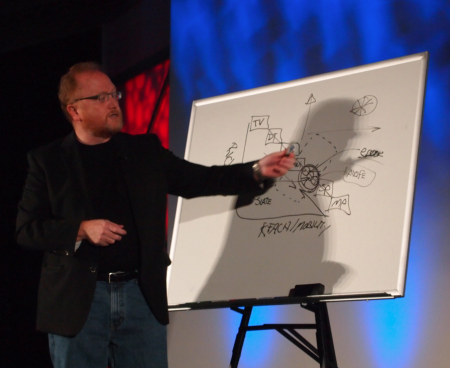
Friday, May 28. 2010
Les Editions Volumiques, Paper computing and curious reading interactions
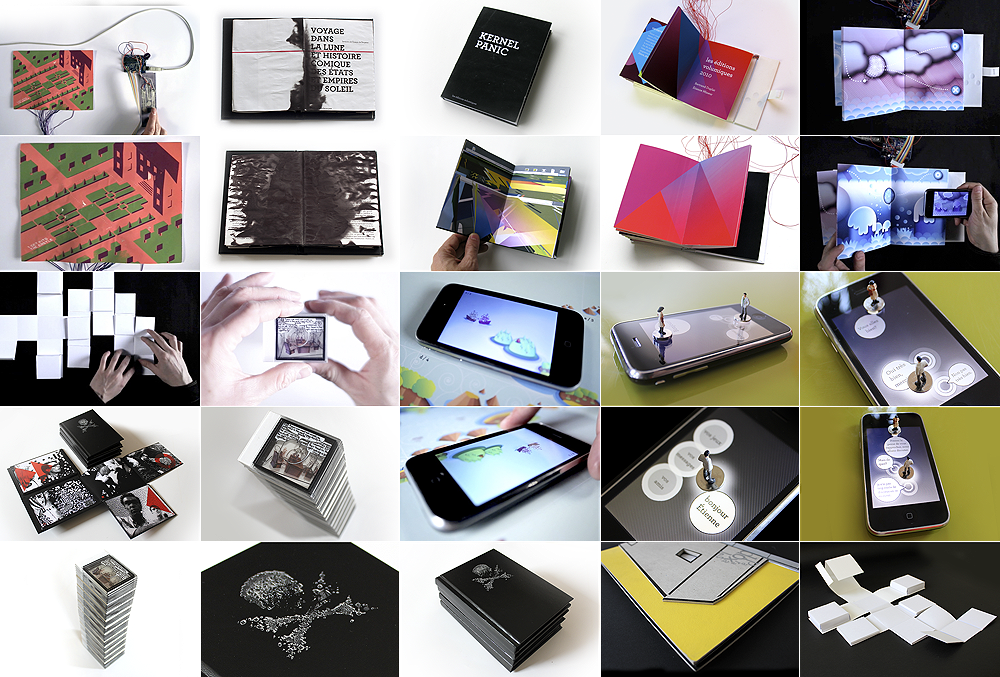
Les Editions Volumiques finally launched their website showing plenty of curious and original products based on mixing paper and digital technologies:
“Here are the first pieces of les évolutions dynamiques following research on both volume and interactivity, playfully mixing paper and computation. By allowing interactivity and gameplay in the page (for example with the Duckette project) or between the pages (in The book that turns its own pages, or Labyrinthe), we try to bring new life to paper. We then pushed physical behavior to paper and ink (the book that disapears). There, the paper is no longer only the frame for representation, but at the same time the field of a real physical experience. We also played with the volume and perspective of book and content (paradoxales, Meeting-Zombies). And then, we tried to combine paper with this little computer-object almost of us all carry everywhere: our cell phone (the night of the living dead pixels, (i) pirates).“
Why do I blog this? I find these projects fascinating and love the idea of mixing digital tech with paper to create compelling user experiences. The examples showed on the picture (see more on their website) are stunning and show the future of books go far beyond boring reading machines. The use of playful metaphors and game mechanics in the work of Bertrand and Etienne are also highly intriguing for those interested in inspiring ways to renew the reading experience.
Besides, if you’re interested in this type of “paper computing”, be sure to check the Papercomp 2010 workshop at Ubicomp. Organized by friends from EPFL, it’s based on similar ideas:
“Paper is not dead. Books, magazines and other printed materials can now be connected to the digital world, enriched with additional content and even transformed into interactive interfaces. Conversely, some of the screen-based interfaces we currently use to interact with digital data could benefit from being paper-based or make use of specially designed material as light and flexible as paper. In a near future, printed documents could become new ubiquitous interfaces for our everyday interactions with digital information. This is the dawn of paper computing. “
Related Links:
fabric | rblg
This blog is the survey website of fabric | ch - studio for architecture, interaction and research.
We curate and reblog articles, researches, writings, exhibitions and projects that we notice and find interesting during our everyday practice and readings.
Most articles concern the intertwined fields of architecture, territory, art, interaction design, thinking and science. From time to time, we also publish documentation about our own work and research, immersed among these related resources and inspirations.
This website is used by fabric | ch as archive, references and resources. It is shared with all those interested in the same topics as we are, in the hope that they will also find valuable references and content in it.
Quicksearch
Categories
Calendar
|
|
April '24 | |||||
| Mon | Tue | Wed | Thu | Fri | Sat | Sun |
| 1 | 2 | 3 | 4 | 5 | 6 | 7 |
| 8 | 9 | 10 | 11 | 12 | 13 | 14 |
| 15 | 16 | 17 | 18 | 19 | 20 | 21 |
| 22 | 23 | 24 | 25 | 26 | 27 | 28 |
| 29 | 30 | |||||
